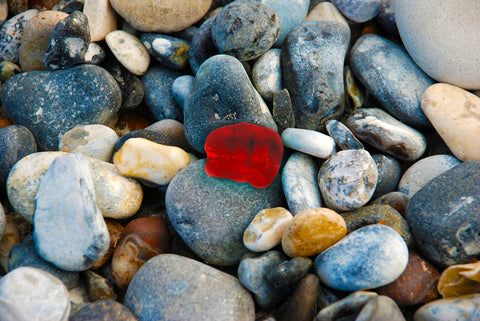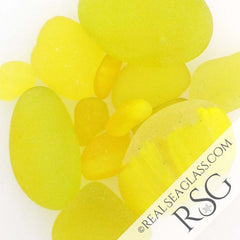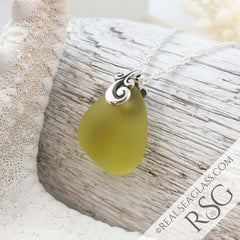All About Red, Orange and Yellow Sea Glass
 Like the sun setting on the sea, these fiery gems are some of the rarest of all…
Like the sun setting on the sea, these fiery gems are some of the rarest of all…
At last, you’ve made it to one of the rare beaches that may have some sea glass… among the rocks and seashells at water’s edge you spot a clear piece … and moments later there’s a brown beauty! Several minutes and a quarter mile later, a flash of green stands out on the sand and you scoop it up. Each of your sea glass shards is lovely, however, on this storm-swept beach you are secretly searching for the Holy Grail of sea glass: red, orange or yellow.
Each of your sea glass shards is lovely, however, on this storm-swept beach you are secretly searching for the Holy Grail of sea glass: red, orange or yellow.
If you chance to fine one, it will be time for the “sea glass happy dance.” More often than not, sea glass lovers spend a lifetime searching for one of these elusive gifts of the sea. True red, orange and yellow are some of the rarest of all sea glass colors, but don’t give up… it is still possible to find one – see our tips below!
About Red Sea Glass
 Think about it: you just don’t see a lot of daily use, household items made from red glass. It’s just not a common glass color for “work-a-day” items, and it never has been. Now that we’ve gone to plastic and aluminum for most containers, it is even more rare.
Think about it: you just don’t see a lot of daily use, household items made from red glass. It’s just not a common glass color for “work-a-day” items, and it never has been. Now that we’ve gone to plastic and aluminum for most containers, it is even more rare.
Red sea glass – true, glowing red – sometimes comes from ship’s lights and other maritime lights. Older shards may once have started as car tail lights or old-time lantern lenses. Red sea glass also comes from Anchor Hocking’s Royal Ruby Glass. This bright red glassware was first made in 1938. It was used to make a variety of fancy dinnerware – everything from plates to cake stands – and was sometimes combined with crystal.
Red sea glass also comes from Anchor Hocking’s Royal Ruby Glass. This bright red glassware was first made in 1938. It was used to make a variety of fancy dinnerware – everything from plates to cake stands – and was sometimes combined with crystal.
Anchor Hocking also made a limited number of beer bottles from Royal Ruby Glass for the Joseph Schlitz Brewing Company (yeah for beer!.) One of my prized sea glass shards is the bottom of one of these bottles… you can still read the embossing! And we can’t forget Avon… yes, the door-to-door mostly cosmetics company produced a wildly popular line of deep red glass dinnerware with the very official name: Avon 1876 Cape Cod Glass Collection. Cape Cod refers to the design of the pressed glass – the inspiration came from the Boston & Sandwich Glass Works founded in 1825 on Cape Cod.
And we can’t forget Avon… yes, the door-to-door mostly cosmetics company produced a wildly popular line of deep red glass dinnerware with the very official name: Avon 1876 Cape Cod Glass Collection. Cape Cod refers to the design of the pressed glass – the inspiration came from the Boston & Sandwich Glass Works founded in 1825 on Cape Cod.
“Sandwich” glass was beautiful pressed glass with intricate designs. One of these designs was called “Roman Rosette” and it is this design that inspired the Avon ruby red pieces. The “1876” is a nod to the 100th anniversary of the signing of the Declaration of Independence. Introduced in 1975 and produced through 1995, Cape Cod dinnerware is most certainly a source of some of the dark red sea glass beauties found today.
Although the process for making red glass was discovered in ancient times, it was lost until the seventeenth century. Red glass can be quite expensive to make. The first red glass required the addition of gold and small amounts of tin.
Anchor Hocking pioneered the addition of copper to produce the rich tone. Today, art glass makers use cadmium and selenium to get that deep, rich glow. But the days of discarding glass in the sea have long passed, making almost all red sea glass found a true historic treasure.
Red Sea Glass - Five Fascinating Facts
- It’s true… gold was used to make the first red glass!
- The original sorcerer’s’ stone described by ancient Greeks thousands of years ago was said to be a red material that had the power to transform common metals into gold!
- Red glass made with gold appears gray at first, and only turns red when it is reheated.
- Deep ruby red glass vessels were prized possessions for Royal families throughout Europe in the late 1600s.
- The Victorians loved their red glass, and pressed glass with intricate patterns became the “thing.”
Red Sea Glass Jewelry
 Red is the color of fire… passion, love and desire. Red symbolizes courage, power, determination and strength. Ruby red gemstones are linked to the life-giving sun in many cultures – hence it is associated with health, wellness and stamina.
Red is the color of fire… passion, love and desire. Red symbolizes courage, power, determination and strength. Ruby red gemstones are linked to the life-giving sun in many cultures – hence it is associated with health, wellness and stamina.
Perhaps red is most known for its ability to boost energy and quick-thinking. Willpower, leadership and decision-making are said to improve in the presence of red.
Red turns heads and attracts attention, and it is linked with enhancing metabolism and boosting energy. Wearing red sea glass jewelry is a great way to tap into your personal passion, power and confidence.
About Orange Sea Glass
 Although finding a piece of red sea glass is considered the pinnacle of beach-combing achievements, discovering a true, clear orange sea glass shard is an even rarer occurrence. Think you haven’t seen much red glass around the house, try finding some orange! Even historically, it just wasn’t ever too popular. (There was that brief stint in the 1970s…)
Although finding a piece of red sea glass is considered the pinnacle of beach-combing achievements, discovering a true, clear orange sea glass shard is an even rarer occurrence. Think you haven’t seen much red glass around the house, try finding some orange! Even historically, it just wasn’t ever too popular. (There was that brief stint in the 1970s…)
An exception is the stunning orange carnival glass that was offered for free or as prizes at traveling fairs and carnivals at the dawn of the 1900s. However, many an “upper-crust” type looked down their nose at this gorgeous glass because of its association with the often rowdy and irreverent carnival crowd. (Like one of my favorite movie lines goes… “We should put a tax on snobbery… they’ll all pay that.” See: The Slipper and the Rose – yes, Richard Chamberlain singing and dancing – but I digress!) Yes, carnival glass was considered quite flashy at the time. Coated with an iridescent pigment before it was fired, carnival glass gives the distinct impression of an oil slick.
Coated with an iridescent pigment before it was fired, carnival glass gives the distinct impression of an oil slick.
And then there is Amberina! Amberina glass displays a blend of rich red and orange to pale yellow. Patented by Joseph Locke of the new England Glass Company (now Libbey glass – yes, that same Libbey that makes the drink glasses in your cupboard,) it was produced from 1883 – 1900.
To make Amberina, you have to use amber glass that contains gold. By repeatedly heating and cooling the glass in a specified sequence the amazing colors and gradients begin to emerge. But, like all glassware, Amberina breaks, and just might turn up decades later as vibrant, genuine sea glass.
But, like all glassware, Amberina breaks, and just might turn up decades later as vibrant, genuine sea glass.
Orange sea glass can also come from lights and shards from lanterns used long before gas and electric light became the norm.
Orange Sea Glass – Five Fascinating Facts
- Tiffany – the stained and leaded glass legend – used richly colored orange glass in his designs.
- Amber sea glass is sometimes mistaken for orange.
- The most famous orange glass is Carnival Glass – and it was once considered “low-brow.”
- Orange glass was used as accents on Art Deco era martini glasses!
- Amberina glass transitions from yellow to red – giving us lovely oranges where the two colors meet!
Orange Sea Glass Jewelry
 Orange is right next to red on the color wheel and shares its ability to symbolize fire… It exudes warmth and courage. It’s a passionate color, but not as intense as bright red. Orange combines the joyfulness and exuberance of yellow with the deep passion of red.
Orange is right next to red on the color wheel and shares its ability to symbolize fire… It exudes warmth and courage. It’s a passionate color, but not as intense as bright red. Orange combines the joyfulness and exuberance of yellow with the deep passion of red.
Orange represents creativity, enthusiasm, success, encouragement and happiness. It is said that orange can evoke increased energy and complete wellness. It is valued for its ability to assist in overcoming illness and disappointment – replacing fatigue and upset with cheerful warmth.
Wearing orange brings a brightness to even the most overcast of days… and can infuse your day with increased creativity, curiosity, joy and action.
About Yellow Sea Glass
 Glass made with mineral selenium develops a sunny yellow color. Before World War I, most glass was made with manganese (which turns purple when exposed to UV light – hence our “Sun Purple” sea glass) which served as a clarifying agent – it made clear glass clearer.
Glass made with mineral selenium develops a sunny yellow color. Before World War I, most glass was made with manganese (which turns purple when exposed to UV light – hence our “Sun Purple” sea glass) which served as a clarifying agent – it made clear glass clearer.
But manganese was needed for the war effort. Glass makers switched to selenium and didn’t return to manganese after the war. Selenium turns yellow when it’s exposed to sunlight. Yellow sea glass is more often very subtle in tone. In fact, you might think that it’s clear when you first find it. Once you place it next to a white surface, you will notice that it has a slight golden glow.
Yellow sea glass is more often very subtle in tone. In fact, you might think that it’s clear when you first find it. Once you place it next to a white surface, you will notice that it has a slight golden glow.
True bright yellow sea glass comes from art glass, stained glass and Depression glass. No matter it’s source, it is extremely rare.
Yellow Sea Glass – Five Fascinating Facts
- The ancient Romans made light yellow glass vessels.
- Yellow glass is not the same as amber, which has golden brown tones, and is not as rare as true yellow given the popularity of beer!
- Depression-era yellow glass – pressed glass tableware and items like vases – was so affordable you could purchase a piece for about the price of a loaf of bread… five cents.
- Yellow glass is used in leaded glass church designs for halos and angel wings.
- The Chinese used yellow glass for snuff bottles in the 1700 and 1800s. Snuff is powdered tobacco thought to be a remedy for illness at the time.
Yellow Sea Glass Jewelry
 Yellow is the color of pure, cloudless sunshine. Yellow reaches out with joy, enlightenment and energy. Yellow is one of the easiest colors to see... that might be what attracted you to it in the first place.
Yellow is the color of pure, cloudless sunshine. Yellow reaches out with joy, enlightenment and energy. Yellow is one of the easiest colors to see... that might be what attracted you to it in the first place.
The sunny glow of yellow creates warmth and boosts mental acuity. Long associated with hope and optimism, yellow has been shown to boost energy.
If you’re looking for the color of positivity you’ve found it! Wear yellow sea glass to bring cheerfulness, mental clarity, improved concentration and energy.
How to Find Red, Orange & Yellow Sea Glass
 Red, orange and yellow sea glass can look like glistening candies when they’re sitting wet on the beach. But unless you live near a sea glass beach and walk it almost daily, you may never come across one of these pieces of sea glass on your own.
Red, orange and yellow sea glass can look like glistening candies when they’re sitting wet on the beach. But unless you live near a sea glass beach and walk it almost daily, you may never come across one of these pieces of sea glass on your own.
But don’t despair… the sea and shore may just surprise you! If you’d like to give sea glass hunting a try:
1. Look for a beach that is known to have Sea Glass.
2. Be sure to be up at the crack of dawn before anyone else hits the beach.
3. Try to arrive right after a storm, or, even better, after a series of storms.
4. Hunt along the rocky areas – look in those crevices! 5. And, don’t be afraid to get wet… sometimes the best treasures are still in the surf!
5. And, don’t be afraid to get wet… sometimes the best treasures are still in the surf!
If you’d like to go the quicker, drier route, you can choose authentic sea glass jewelry that features real, surf-tumbled reds, oranges and yellows in pendants, bracelets, rings or earrings.
Beware of red, orange or yellow sea glass at a surprisingly low price. Almost always this sea glass isn’t real – it’s just fake contemporary, machine-tumbled glass. Although some people use a rock tumbler or acid to try and etch the surface of glass in order to make it resemble sea glass, they can’t replicate this unique, uneven surface that makes real sea glass so beautiful.
 Real sea glass has had an exciting, and long, life. Years and years in the sea give each shard a unique frosted finish with one-of-a-kind pores and micro-markings. If you look at real sea glass under a microscope, you’ll see tiny hills and valleys, and often distinctive C-shaped etchings.
Real sea glass has had an exciting, and long, life. Years and years in the sea give each shard a unique frosted finish with one-of-a-kind pores and micro-markings. If you look at real sea glass under a microscope, you’ll see tiny hills and valleys, and often distinctive C-shaped etchings.
Wearing a piece of fire-toned sea glass brings radiance to every day. Your ultra-rare Bit of the Beach is your daily tie with the peace, serenity and power of the surf and sky. A one-of-a-kind, your real sea glass reflects your unique personality. Whenever you have yellow, orange or red real sea glass in your hand, know that you’re holding a matchless treasure that most people will never have the opportunity to experience.
Whenever you have yellow, orange or red real sea glass in your hand, know that you’re holding a matchless treasure that most people will never have the opportunity to experience.
See our Red Sea Glass jewelry here>
See our Orange Sea Glass jewelry here>
See our Yellow Sea Glass jewelry here>




